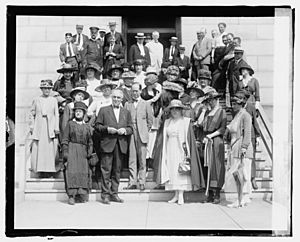Helen Hoy Greeley facts for kids
Quick facts for kids
Helen Hoy Greeley
|
|
|---|---|
 |
|
| Born | 20 January 1878 Albany |
| Died | 21 November 1965 Charlottesville |
| Occupation | Suffragist, lawyer |
| Spouse(s) | Harold Dudley Greeley |
Helen Hoy Greeley (born January 20, 1878 – died November 21, 1965) was an American suffragist and lawyer. She was a strong voice for women's right to vote and worked to improve conditions for nurses in the military.
Contents
Growing Up and Education
Helen Katherine Hoy was born in Albany, New York, in 1878. Her father, Charles T. Hoy, worked in prisons. He helped make prisons cleaner and started libraries there. Her mother, Lucy M.S. Hoy, was an assistant principal at a public school.
Helen went to Albany High School. Then she attended Vassar College, graduating in 1899 with high honors. After college, she taught Greek and English for three years. She taught at private schools and an evening high school for women in New York City. Later, she decided to become a lawyer.
Helen Hoy married Harold D. Greeley, who was also an attorney, on August 29, 1908.
Becoming a Lawyer
Helen earned her law degree (Bachelor of Laws or LLB) from New York University in 1903. She was the top student in her class. That same year, she became a licensed lawyer in New York.
She started her own law firm, Hoy and Martin, with Sarah E. Martin. Helen also worked for important groups like the New York Charter Revision Commission. She represented teachers' associations and groups working for women's right to vote. Helen helped write laws, including one that created the New York Department of State Police. She also drafted a law that gave military rank to army nurses.
Fighting for Women's Vote
In 1907, Helen became an early member of the Equality League of Self-Supporting Women. This group, started by Harriot Stanton Blatch, wanted women to have the right to vote. They used strong, active ways to get their message out. The group included professional women like Helen, along with many working women.
Helen joined a "trolley car campaign" to spread the word about women's voting rights. She traveled across New York, speaking to people. She also joined other activists at Vassar College. They held a pro-suffrage meeting near the campus because the college president did not allow such gatherings on school grounds.
Helen was a founder of other important groups, like the College Equal Suffrage League of New York. She also held leadership roles in various Woman Suffrage Parties. She marched in the first suffrage parade in New York. Helen was known for speaking on a street corner for 56 nights in a row to show how effective it was.
Campaigning in California
In 1911, Greeley traveled to California to help convince voters to support women's suffrage. She visited Sonoma, San Francisco, and other areas. She worked with other politicians and activists from across the country. Helen pointed out that over 8,500 women were teachers in California. Yet, they could not vote for the person in charge of schools.
During the final days of the California campaign, Helen spoke to a crowd of 4,000 people outdoors. Another 6,000 attended a large meeting indoors. After women won the right to vote in California in 1911, Helen returned in 1912 to support a presidential campaign.
Work in Portland
In 1912, Helen Greeley and Charlotte Anita Whitney helped suffrage groups in Portland. They gave talks in homes and at clubs. They also helped start a Portland chapter of the College Equal Suffrage League. Helen often spoke to the Portland Equal Suffrage League. She challenged President Roosevelt's views on women's suffrage.
Creative Campaigns
In 1913, Greeley created the "Rainbow Campaign." Suffragists handed out five different colored flyers to homes in New York. This campaign showed Helen's creative ways to get attention for the cause. She wanted people to think carefully about voting for women's rights. She told men not to vote "yes" just because a woman asked them to. Instead, she urged them to consider the arguments and vote based on their honest beliefs.
In 1914, Helen traveled to Dover, Delaware. She was a main speaker at the state suffrage convention there.
Getting Rank for Nurses
From 1918 to 1920, Helen focused on getting military rank for army nurses. She believed this was important for women's dignity. She helped organize the National Committee to Secure Rank for Army Nurses. Helen was the legal advisor for this group.
The group wanted all military nurses to be recognized as officers. Helen said that nurses, despite their training, had less authority than a hospital orderly. She argued that this lack of authority made their work harder. She believed giving nurses military rank would improve morale and efficiency.
Helen Greeley became a leading activist for army nurses. She challenged military leaders who thought women did not need military rank. She believed nurses deserved more respect and recognition. On June 4, 1920, a law was signed that gave nurses military rank. They received the same social rights as other officers, but not equal pay.
Other Important Work
Helen Greeley was also involved in other community efforts in New York. She helped improve the city and worked to remove old railroad tracks. She was also part of the Women's Municipal League.
She worked for peace and justice, too. She spoke about freeing political prisoners and the need for disarmament (reducing weapons). She provided legal help to groups like the NY Council for the Limitation of Armaments. She also worked with the Women's Committee for World Disarmament.
After women gained the right to vote, Helen moved to Milwaukee. She became a lawyer in Wisconsin. In the late 1920s and early 1930s, she worked for the League of Nations, focusing on disarmament. She retired in the 1940s from her job with the U.S. Department of the Interior.


